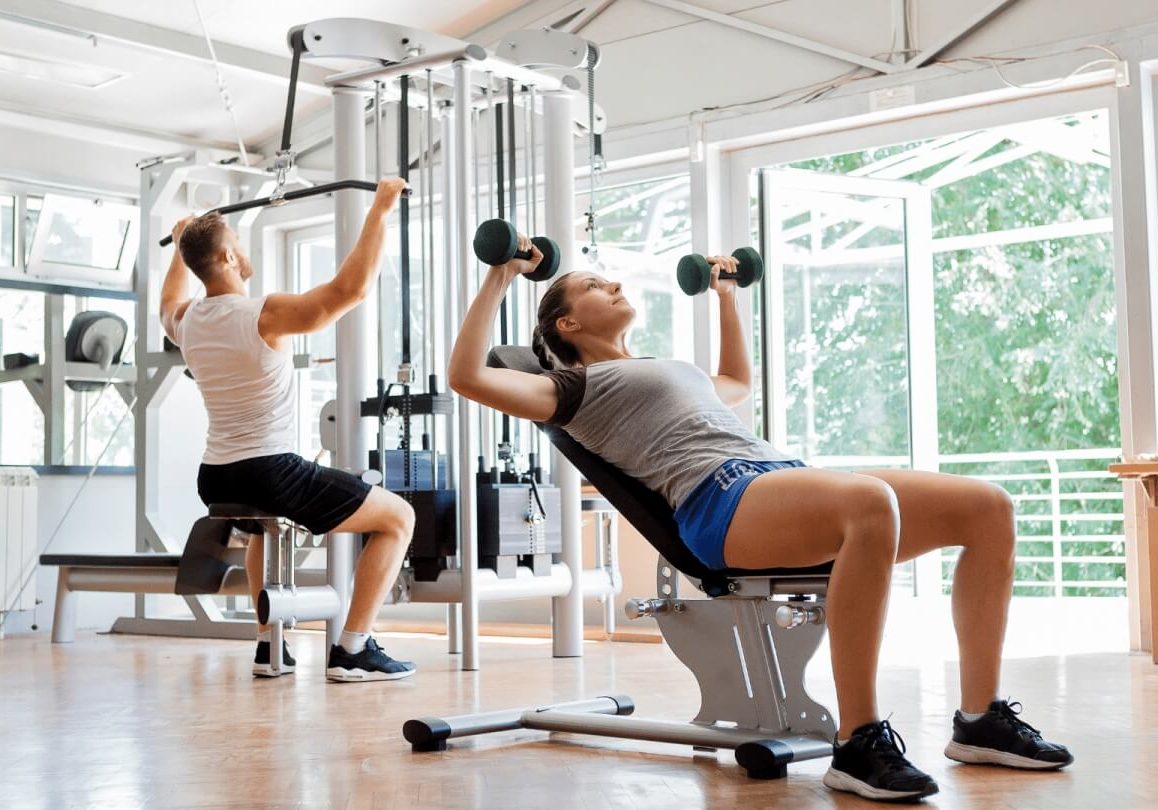What happens if you exercise without dieting? Does exercise help you lose weight?

Many people believe that if you work out regularly, you’ll eventually lose weight. Or, if you eat a donut, you should walk for about an hour to burn equivalent calories. Or when you put in some extra time at the gym, you can afford to splurge a little. Unfortunately, none of these are true, and

“Exercise isn’t a weight loss tool per se. It’s excellent for health. It’s probably the best single thing that you can do for your health other than stopping smoking to improve your health, but don’t look at it as a weight loss tool.” – Dr. Kevin Hall, Senior Investigator, National Institute of Health
In this article, we’ll cover the role of exercise in weight loss, why you might be struggling with weight loss, and share some tips to help get you on the road to weight loss success.
Does Exercise Help You Lose Weight?

The idea is that if you increase the number of calories you burn throughout the day by adding exercise, you should be at a caloric deficit and, therefore, lose weight. Sadly, it’s not that simple. Our bodies burn calories in three ways.
- Resting Metabolic Rate (RMR): The number of calories you burn at rest and what your bodyneeds to maintain basic bodily function. RMR makes up about 70% of the calories you burn each day.
- Thermic effect of food (TEF): The amount of energy your body uses to digest, absorb and metabolize food. TEF makes up about 10% of what you burn daily.
- Physical activity: Includes any movement throughout the day and makes up between 10 to 30% of what you burn.
RMR makes up well over half of the calories you use throughout the day. Because that’s the case, you can’t directly control most of how your body uses energy. You have complete control over how many calories you take in. However, you only have control of about 30% of the calories out, and that’s not a lot.
When you exercise, while you initially might begin losing weight, your body will eventually adjust to burning fewer calories even with the same amount of exercise. Exercise can also make you hungrier, so you want to eat more.
A fascinating study in 2012 examined a Tanzanian hunter-gatherer tribe called the Hadza and their energy expenditure (the rate at which you burn calories). As a people, they are physically active all day long. It would be logical to assume that their energy expenditure would be greater than Americans or Europeans who spend much of their day sitting at desks or otherwise being relatively sedentary.
The results, however, shocked even the scientists. The energy expenditure of the Hadza people was no different from that of Western office workers. Therefore, physically active people don’t burn more calories than sedentary people.
What’s going on there? Scientists believe that it’s because our bodies adapt over time. If you spend energy on exercise, your body responds by spending less on other things that make up your RMR.
In a review of studies, researchers examined the relationship between exercise and weight loss. While exercise improves all aspects of health and decreases cardiovascular disease risk, it’s not effective for long-term weight loss success.
What Happens if You Exercise Without Dieting?
Psychological shifts
Why doesn’t exercise alone cause weight loss? When you begin to exercise, you may experience a psychological shift that undermines your efforts making you more likely to engage in compensatory behaviors.
It’s pretty easy to undo the hard work you put in at the gym. In a controlled study, 41 healthy subjects exercised for 45 minutes and then took a food preference survey. After just one round of exercise, subjects were more likely to eat more food than the control group.
You might also reduce your activity level by slowing down or taking the elevator instead of the stairs. While studies are inconsistent, some clearly show a decrease in physical activity when you exercise regularly.
When you don’t see those weight loss results from exercise, it’s not very motivating to keep it up.
A study of 30 overweight participants followed their attitudes toward exercise throughout a 12-week exercise program. Most participants were more motivated to exercise for weight loss rather than the health benefits. When weight loss from exercise proved unsuccessful, participants began to feel pessimistic about the exercise experience and were more likely to quit.

Physical shifts
Your body may also begin to compensate for your added exercise. The idea is that your body begins to fight against weight loss to protect itself from starvation.
In a meta-analysis of 15 studies, researchers examined the effects of exercise on weight loss. Overall, participants who exercised more experienced less weight loss. Participants had only a small negative energy imbalance compared to the number of calories burned from exercise (the difference between calories consumed and calories burned).
The small imbalance may be due to a couple of reasons. Some participants increased their caloric intake. For those who did not increase their caloric intake, RMR decreased by about 7%, indicating metabolic adaptation.
If you’re going by the number of calories on an exercise machine, it doesn’t take this metabolic adaptation into account.
To lose weight, you must both change your diet and exercise regularly.
A meta-analysis of 66 studies examined the effectiveness of exercise, diet, or diet with exercise on weight loss. Participants consistently experienced more weight loss when combining exercise and diet versus exercise or diet alone.
Regardless of whether exercise was low or high intensity or whether the diet was low carbohydrate or high protein, any combination of diet and exercise combinations increases the likelihood of successful weight loss.
Why Am I Not Losing Weight When I Exercise and Diet?
What if you exercise regularly, maintain a healthy diet, and still don’t lose weight? You’re missing an essential piece of the puzzle: caloric deficit. While many factors are involved in weight loss, a caloric deficit is one of the most important.
A meta-analysis explored optimal diet strategies for weight loss. Researchers found that while the type of diet wasn’t important, participants consistently lost weight following a calorie-restricted diet.
Remember we talked about the three ways that your body burns calories. You have control of about 30%. Even if you’re burning calories by exercising, if you’re eating more than you burn, you will not be able to lose weight.
What to Do if You Want to Lose Weight?
When you think about weight loss, your goals are probably not just a lower number on the scale. You probably want to lose fat and look better too. We’ve got some strategies to help you reach your goals.
1. Find out your maintenance calories and reduce caloric intake to be in a deficit
We discussed above how important it is to be in a caloric deficit to lose weight, but how do you figure that out? You’ve got to figure out your RMR. The most accurate formula to calculate it is the Mifflin-St Jeor.
- For men: RMR = 9.99 x weight in kg (weight in lb ÷ 2.2) + 6.25 x height in cm (height in inches x 2.54) – 4.92 x age +5
- For women: RMR = 9.99 x weight in kg (weight in lb ÷ 2.2) + 6.25 x (height in inches x 2.54) – 4.92 x age – 161
To factor in your muscle mass and activity level, you would need to take an RMR breathing test with a health practitioner for an even more precise calculation.
Once you know your RMR, it’s time to reduce your calories by eating fewer and burning more calories with exercise. To ensure your deficit isn’t too extreme and risk metabolic adaptation, shoot for no more than 500-1,000 calories per day less than your RMR.
2. Resistance train to build and maintain muscles

If you exercise and diet with a caloric deficit, you will lose weight, but you also risk losing muscle mass and not reaching your physique goals. If you add resistance training to your routine, you can reduce your body fat and increase your muscle mass.
In a study of nine lean and eight obese subjects, researchers wanted to understand the effects of resistance training on body fat. After just 30 minutes of resistance training, both lean and obese participants experienced an increased fat breakdown and calorie burning.
Building muscle mass and exercise adaptations like getting stronger burn a lot of calories, which can contribute to your caloric deficit.
Maintaining muscle mass also keeps weight off in the long run. It does this in a couple of ways.
- When you increase your muscle mass through resistance training, you can increase your RMR, which means you’re naturally going to burn more calories daily.
- When you improve your strength, you are more likely to be more physically active throughout the day and increase your total energy expenditure.
You also need to provide your body with the protein it needs to build your muscles. Make sure to get between 1.6–2.4 g/kg (0.73-1.0 g/lb) of protein to lose weight but preserve lean body mass.
3. Follow the diet that works best for you long-term based on the hierarchy of the nutritional decision
There isn’t one diet that is best for everyone. We each have our own physical, mental, and spiritual needs to be our best selves. Following the BiOptimizers Pyramid of Nutritional Decisions will help you reach your goals based on your unique needs.
The foundation of your food choices begins with honoring your spiritual, cultural, physical, and emotional needs. From there, focus on your goals and then move on to these5 key diet optimizers.
- Calories and macros: Consume the right number of calories in the right percentages of macros.
- Nutrigenomics: Choose the diet, foods, and supplements that work with, not against, your genetic tendencies.
- Gut microbiome: Support your gut to help your good bacteria thrive.
- Supplements: Understand how to best support your body nutritionally beyond food.
- Food sensitivities, allergies, and intolerances: Know what foods to avoid to minimize food-related inflammation.
The final step is ensuring that whatever choices you make are sustainable for your lifestyle for a lifetime.
To dig deep into this idea and develop the perfect diet based on your genetics, gut biome, and psychology, BiOptimizers has the ideal tool for you, The Nutrition Bible. Be the first to access the exciting guide by getting on our waitlist now. You’ll get a sneak peek into the preface and chapter one when you sign up.
4. Have a plan for once you reach your goals
Once you reach your weight loss and physique goals, you need to have a plan to maintain them. If you don’t think long-term, you can get stuck in a vicious cycle of weight loss and regain. Your plan should include the following:
- Diet cycling and refeeds help prevent your metabolism from slowing down. These strategies also allow you to build in festivities and social occasions to support your physique goals.
- Getting quality sleep to prevent unnecessary weight gain
- Keeping your stress levels down to avoid fat gain
- Reverse diet and maintain your results healthfully rather than jumping back into your old eating habits

5. Overall become more active and mix all types of physical activity, emphasizing the ones you enjoy
Keep moving throughout the day to lose weight and keep it off. You’re more likely to lose weight successfully when you modify your lifestyle to move beyond just when you exercise.
In a study of 3,683 individuals enrolled in the National Weight Control Registry, researchers examined physical activity in relation to successful weight loss. Those who were most physically active (3,500+ calories burned per week) lost more weight and maintained their weight loss for extended periods.
There is no exact right way to be physically active. Just do what’s right for you. In the above study, participants were successful by doing a combination of the following:
- Taking the stairs
- Walking extra blocks
- Cycling
- Running
- Doing aerobics
- Using cardio machines like the treadmill or a Stairmaster
- Floor conditioning such as yoga, pilates, or floor exercises
- Swimming
Overall, just keep moving and do what you enjoy. When intrinsically motivated, you’re more likely to stick to it in the long run and be successful. Consistent movement throughout the day significantly impacts your health and weight loss more than just one hour in the gym.
- Maintain a caloric deficit through food and other metabolism maximization strategies.
- Add resistance training to your routine to build and maintain muscle mass.
- Determine the perfect diet based on the nutritional hierarchy and learn even more about this exciting approach by signing up for the waitlist for The Nutrition Bible today.
- Have a plan in place to maintain your weight loss after you reach your goal.
- Get up and move! Find ways to incorporate physical activity daily to ensure your weight-loss goals and long-term success.
The Takeaway
If you’re hoping to lose weight, exercise and diet go hand in hand. You can’t eat less and not exercise, or choose to exercise without changing your diet. What you eat matters even more than exercise regarding weight loss. Doing the following will get you on the pathway to success:
- Maintain a caloric deficit through food and other metabolism maximization strategies.
- Add resistance training to your routine to build and maintain muscle mass.
- Determine the perfect diet based on the nutritional hierarchy and learn even more about this exciting approach by signing up for the waitlist for The Nutrition Bible today.
- Have a plan in place to maintain your weight loss after you reach your goal.
- Get up and move! Find ways to incorporate physical activity daily to ensure your weight-loss goals and long-term success.
- Calcagno M, Kahleova H, Alwarith J, et al. The thermic effect of food: A review. J Am Coll Nutr. 2019;38(6):547-551. doi:10.1080/07315724.2018.1552544
- Dorling J, Broom DR, Burns SF, et al. Acute and chronic effects of exercise on appetite, energy intake, and appetite-related hormones: The modulating effect of adiposity, sex, and habitual physical activity. Nutrients. 2018;10(9). doi:10.3390/nu10091140
- Pontzer H, Raichlen DA, Wood BM, et al. Energy expenditure and activity among Hadza hunter-gatherers: HADZA ENERGETICS AND ACTIVITY. Am J Hum Biol. 2015;27(5):628-637. doi:10.1002/ajhb.22711
- Pontzer H, Durazo-Arvizu R, Dugas LR, et al. Constrained total energy expenditure and metabolic adaptation to physical activity in adult humans. Curr Biol. 2016;26(3):410-417. doi:10.1016/j.cub.2015.12.046
- Swift DL, McGee JE, Earnest CP, Carlisle E, Nygard M, Johannsen NM. The effects of exercise and physical activity on weight loss and maintenance. Prog Cardiovasc Dis. 2018;61(2):206-213. doi:10.1016/j.pcad.2018.07.014
- Melanson EL, Keadle SK, Donnelly JE, Braun B, King NA. Resistance to exercise-induced weight loss: compensatory behavioral adaptations: Compensatory behavioral adaptations. Med Sci Sports Exerc. 2013;45(8):1600-1609. doi:10.1249/MSS.0b013e31828ba942
- Koehler K, Beckford SE, Thayer E, Martin AR, Boron JB, Stevens JR. Exercise shifts hypothetical food choices toward greater amounts and more immediate consumption. Nutrients. 2021;13(2):347. doi:10.3390/nu13020347
- Melanson EL. The effect of exercise on non-exercise physical activity and sedentary behavior in adults: Exercise and total daily energy expenditure. Obes Rev. 2017;18:40-49. doi:10.1111/obr.12507
- Paravidino VB, Mediano MFF, Hoffman DJ, Sichieri R. Effect of exercise intensity on spontaneous physical activity energy expenditure in overweight boys: A crossover study. PLoS One. 2016;11(1):e0147141. doi:10.1371/journal.pone.0147141
- Guess N. A qualitative investigation of attitudes towards aerobic and resistance exercise amongst overweight and obese individuals. BMC Res Notes. 2012;5(1):191. doi:10.1186/1756-0500-5-191
- Thomas DM, Bouchard C, Church T, et al. Why do individuals not lose more weight from an exercise intervention at a defined dose? An energy balance analysis: Why do individuals not lose weight from exercise? Obes Rev. 2012;13(10):835-847. doi:10.1111/j.1467-789X.2012.01012.x
- Clark JE. Diet, exercise or diet with exercise: comparing the effectiveness of treatment options for weight-loss and changes in fitness for adults (18-65 years old) who are overfat, or obese; systematic review and meta-analysis. J Diabetes Metab Disord. 2015;14:31. doi:10.1186/s40200-015-0154-1
- Kim JY. Optimal diet strategies for weight loss and weight loss maintenance. J Obes Metab Syndr. 2021;30(1):20-31. doi:10.7570/jomes20065
- Frankenfield D, Roth-Yousey L, Compher C. Comparison of predictive equations for resting metabolic rate in healthy nonobese and obese adults: a systematic review. J Am Diet Assoc. 2005;105(5):775-789. doi:10.1016/j.jada.2005.02.005
- Chatzinikolaou A, Fatouros I, Petridou A, et al. Adipose tissue lipolysis is upregulated in lean and obese men during acute resistance exercise. Diabetes Care. 2008;31(7):1397-1399. doi:10.2337/dc08-0072
- Petridou A, Siopi A, Mougios V. Exercise in the management of obesity. Metabolism. 2019;92:163-169. doi:10.1016/j.metabol.2018.10.009
- Catenacci VA, Ogden LG, Stuht J, et al. Physical activity patterns in the National Weight Control Registry. Obesity (Silver Spring). 2008;16(1):153-161. doi:10.1038/oby.2007.6
- Martinez M, Salazar-Collier CL, Pena J, Wilkinson AV, Chavarria EA, Reininger BM. Motivation for weight loss among completers of a free community-based weight loss program in a US-Mexico border region: A self-determination theory perspective. Front Public Health. 2022;10:652271. doi:10.3389/fpubh.2022.652271
- Rollo S, Antsygina O, Tremblay MS. The whole day matters: Understanding 24-hour movement guideline adherence and relationships with health indicators across the lifespan. J Sport Health Sci. 2020;9(6):493-510. doi:10.1016/j.jshs.2020.07.004







